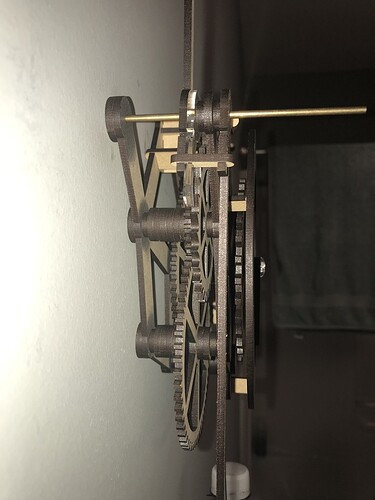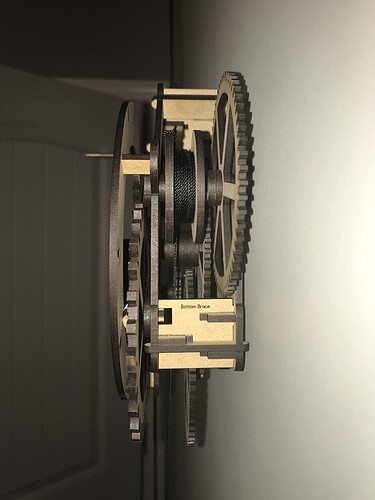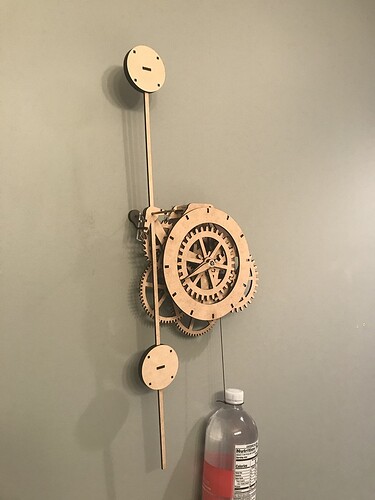I am discovering that my pendulum design is WAY over engineered. It is much bigger than is necessary. I keep making it smaller and I think I can go even smaller yet. We will see how far it goes, but right now I think I am at least half of my original weight.
Here’s a video from Brian Law about a prototype that he has been working on to replace the swinging pendulum. Just thought you might find it interesting.
I do remember seeing that one in my research, but with my first clock I wanted to go a simpler route.
Brian Law’s information about clocks has been a HUGE help in my journey. I have been very inspired by his designs and I have learned a lot from the information he posts.
I just got his book. He has a clock build that uses it but he did say, it has been promising with 3D printer versions of it.
I bought his book too. Someone loaned it to me originally, but I liked it so much I wanted my own copy.
I was surprised that most of his clocks don’t run for that long (~25 hours is the longest).
I am trying to get mine to run for 36 hours, if I can…
I’m still researching the processes, starting with the book. If you go back and reread the section on the power source, he talks about making the drive gear on the cord pulley bigger to increase run time. There are also some great pulley combinations that he diagramed that would help with run time as well. Per our previous exchanges, if you built the larger gear and mounted it to the cord drum then coupled that with the multi pulley layouts that Mr Law discussed, you should be able to get close, if not exceed that. Just keep in mind, this is all theory from a novice still waiting on delivery of my GF+ but they are things to consider and ponder.
I already added a gear to the end of the chain (so I didn’t mess with the ratio between the escapement and the minute axle) to increase the run-time. I am also looking at adding a pulley to the weight (only if it doesn’t reduce the torque to much).
I am really just focusing on getting it running first, but I am still wanting to get the run-time as long as possible.
From my experience, the best way to allow your clock to run for as long as possible is to reduce friction everywhere you can, so you don’t need as much torque, because every method for extending the run-time has the effect of reduced torque in your gears. It is conserving power and spreading it out over a longer period of time.
To increase torque, I could add weight, but I have been so hesitant to do that with the frame issues I have been having.
As much as you want this to be all “made on a glowforge”, I wonder if you’re chasing something that would be easily solved with a couple of cheap bearings?
If I thought some bearings would fix a problem, I would use them. At this point, I do not know where bearings would be helpful.
OK. Just seemed like you were chasing a lot of friction issues.
Actually, maybe I can work with that… I have been trying to figure out how to improve the minute axle. Maybe a bearing is the answer?
That is the only axle that is not brass at this point. Well that and the hour-gear-down.
It might at least eliminate the friction there as an issue. When there are many factors at play, you can benefit from eliminating them one-by-one while you work it out. Applies to many things.
Doesn’t mean it has to be part of the final design.
The more I look into this, the more it seems like it would be worth a try.
I need to see if I have some bearings around the house I can play with… I think one of the kids had a fidget-spinner they broke…
Edit: I found the broken spinner, harvested a bearing, and now I am going to do some tests to see if I can make this work for the minute-axle.
I wonder if this is the time to implement @designvh619’s printed disc-bearing? ![]()
I created one that was 1.43" inside-diameter… I could probably go a little smaller, but I haven’t tested that… ![]()
![]()
Edit: The steel bearing does test very nicely, so I might incorporate that into my next frame.
My only question is, do you think I should use two bearings (one in back and one in front) or just one bearing where the weight of the axle is pivoting (in the front)?
I’d think you could test that without building an entire mechanism? Just a couple of test pieces supporting each end, one with one bearing, one with two? See what difference it makes?
Well, I have tested the steel bearing with some scraps and they are working really well. So, I will probably try to work those into the frame in the front and back (I think I have plenty of room.)
But, I think the majority of my friction is coming from the hour-gear… and I do not currently have enough room to implement a bearing there. So, I will have to look at what options I can come up with there.
My pendulum is still not long enough, so I am breaking it in half. I will make it as long as can and still utilize space efficiently. Since it is a compound pendulum, I plan to join the two pieces at the axle and hopefully help balance the pendulum front to back (I have noticed it leaning.)
Well, I finished the new pendulum.
But I also realized I was adjusting it incorrectly… So the old pendulum was probably fine…
To slow down a compound pendulum you lengthen to bottom, or shorten the top. I was lengthening them both (which would have been fighting each other).
I like the new pendulum, but it is REALLY difficult to assemble. So I doubt I will keep that design. Here is a photo from the side. You can see the top-part is behind the escapement and the bottom-part is in front.
I like the balance it gives, but it is not worth the effort to assemble (I don’t think).
Here is a photo of the new frame-brace.
I am very happy with how it worked out, but it is also in the way if I try to install a bearing for the hour-gear…
My next plan is to install bearing for the front and back of the minute-axle and possible rotate the hour-axle away from the brace to fit another bearing there.
If all that works out. I might start looking at improving the method to wind the clock or add a pulley to increase run time (if the friction is reduced enough).
Yep… I completely misread (or misunderstood) about compound pendulums.
I was extending both sides in an attempt to slow down the clock. But what I really needed was to shorten the bottom to extend the period.
In this configuration it is running slow.
So I can probably adjust my design a couple iterations back and make a much smaller pendulum and conserve space. Which will also reduce mass in the pendulum and as a result reduce the torque needed from the gear-chain.
(On a side note. My girls grabbed the two pieces of the pendulum and are running around using them like wands.)
I think I have worked out the new frame.
I was able to rotate the axle for the hour-gear out of the way, and I think it will still clear everything (I hope). The bearing should make it run smoother and keep it from stopping (again, I hope). This is that last area that I find that could have added friction. So unless I have an axle radius slightly off, this should fix it.




